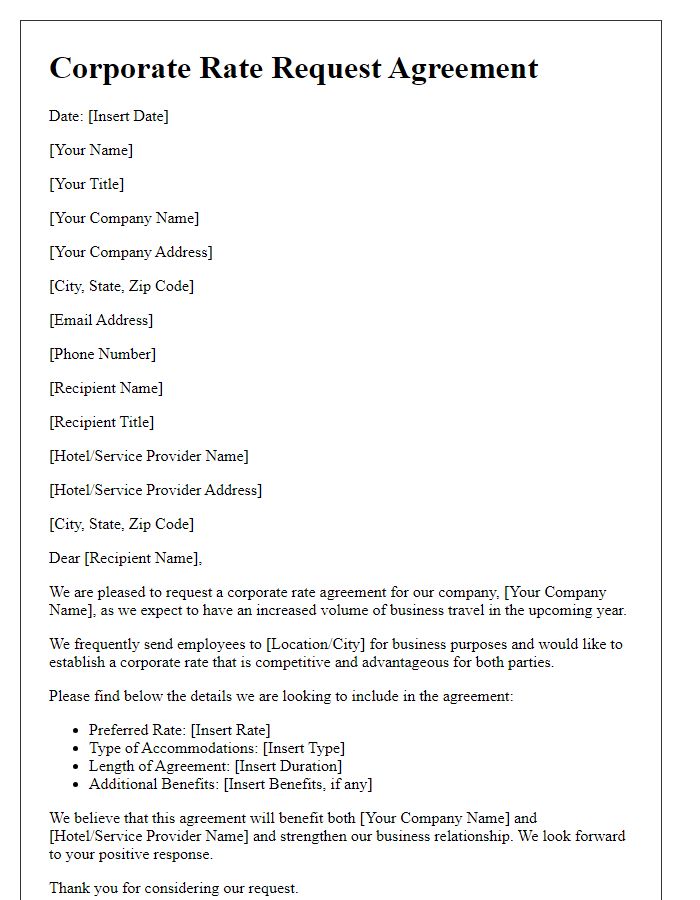Welcome to our guide on crafting a corporate rate agreement letter! If you've ever found yourself needing to negotiate rates that align with your business needs, you're in the right place. This letter serves as a formal way to outline the specific terms and conditions of your agreement, ensuring clarity and mutual understanding between parties. Ready to dive deeper into the essentials of creating an effective corporate rate agreement? Let's explore together!

Business Goals Alignment
In a corporate rate agreement, aligning business goals is crucial for ensuring mutual benefits for both parties involved. When negotiating terms, it is important to establish shared objectives that promote sustainable growth and profitability. Identifying specific metrics, such as revenue targets or customer acquisition rates, fosters a collaborative relationship. Regular evaluation meetings, ideally quarterly, can help assess progress toward these goals, allowing for adjustments as necessary. Additionally, incorporating performance incentives based on goal achievement can enhance commitment and drive results. Documenting these aligned goals within the agreement solidifies the partnership's focus on mutual success and accountability, ensuring that all parties clearly understand their roles and contributions.
Mutual Benefits
Corporate rate agreements enable businesses to secure advantageous pricing structures. These arrangements often facilitate cost savings, especially when negotiating bulk purchases or long-term contracts with service providers, such as hotels, airlines, and car rental companies. For instance, corporations may achieve discounted rates during peak seasons, allowing employees to travel for conferences or business meetings at locations like New York City or Los Angeles, where expenses can be substantial. Establishing mutual benefits enhances partnerships, ensuring both parties thrive financially, while fostering loyalty and continued collaboration. Key metrics for evaluating effectiveness include overall savings percentage, utilization rates, and customer satisfaction scores from employees using these corporate rates.
Pricing Structure
Pricing structures for corporate rate agreements often include tiered pricing based on volume of usage, availability of discounts for long-term contracts, and specific rates applicable to different services offered. Companies like Hilton (established in 1919) and Marriott (founded in 1927) frequently utilize these structures, attracting corporate clients by offering tailored packages that may include perks such as complimentary breakfast, access to conference rooms, and loyalty points. The pricing model can vary significantly across regions, for instance, metropolitan areas like New York City and San Francisco often have higher rates due to elevated demand and operating costs. Essential details often highlighted include payment terms, cancellation policies, and any additional fees, ensuring clarity and mutual understanding.
Duration and Terms
A corporate rate agreement typically encompasses a defined duration and specific terms that govern the relationship between the service provider and the corporate client. The duration of the agreement usually spans a predetermined period, often ranging from one year to three years, allowing businesses to secure consistent pricing for services offered, such as hotel accommodations or transportation. The terms include conditions related to billing cycles, cancellation policies, and usage limits. Additionally, agreements may delineate the benefits provided, such as discounted rates, priority bookings, and additional amenities for corporate clients. Such agreements play a crucial role in fostering long-term partnerships and ensuring mutual satisfaction in service provision.
Contact Information
Corporate rate agreements can provide significant savings for businesses requiring frequent bookings in hotels. When negotiating such agreements, essential contact information should be meticulously recorded, encompassing elements such as the company name, primary contact person, email address, phone number, and billing address. Additionally, the agreement must state the number of rooms or services estimated, check-in and check-out dates, special requirements such as conference room usage or catering services, and payment terms, ensuring clarity and mutual understanding between the hotel and the corporation. Accurate and organized contact information serves as a vital foundation for effective communication and management of the corporate relationship.













Comments